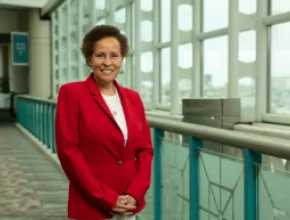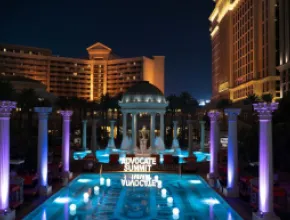Presenting jaw-dropping options, new tribal casino resorts and expansions continue to make their grand entrance in the West. As destinations are rounded out, in addition to new upscale hotels there is an emphasis on building large flexible venues for concerts and sports adaptable for meeting events.
New gathering places with headliner entertainment are appearing in California’s already casino-packed regions and in places such as metro Seattle and Phoenix. They are also popping up in sparse, unexpected areas such as Yuma, Ariz., and in southwest Colorado, where reservations straddle state borders.
While developers continue to roll the dice, some plans and construction projects were put on hold after credit markets froze. And while casinos tout their latest deals and payouts, business overall is clearly down.
California
America’s leading state in terms of Native American casino revenue now has 60 casinos, about a third of which have hotels and meeting space. Together they have more than 60,000 gaming machines and almost 2,000 table games.
“Casinos near population centers seem to be doing better than others in this difficult economy,” says Alan Meister, a Los Angles-based economist with the Analyst Group, who produces the annual Indian Gaming Report for the Casino City directory.
Meister explains that casino gaming revenue growth had been slowing down for some years. According to his 2008-2009 report released last summer, California’s 2007 gaming revenues increased only 1.6 percent to $7.8 billion while casinos’ non-gaming revenues jumped 13.9 percent to almost $1 billion, more than doubling in five years.
He attributes pre-recession dwindling gaming growth to a public policy restricting casinos rather than a saturated market. Under the first compacts, or agreements, signed by the state with individual tribes over a decade ago, each tribe was limited to a maximum of 2,000 Las Vegas-style Class III slots.
Gov. Arnold Schwarzenegger has since pushed to expand gambling operations substantially, negotiating new and amended compacts with individual tribes that allow more machines in return for much larger payments to state coffers.
Ironically, the big news came in February last year—just as recession was beginning to bite—when voters ratified amended compacts with four of the largest casino operators: the Pechanga, Morongo, Agua Caliente and Sycuan tribes. While the amended compacts allow the tribes to collectively add 17,000 more slots, they have so far added less than 3,000.
The upscale 522-room Pechanga Resort in Temecula has expanded casino operations the most of any property. In November, the resort held the grand opening for its new 18-hole Journey at Pechanga golf course. Already offering 40,000 square feet of indoor meeting space, the resort added a new 62,000-square-foot clubhouse with banquet space for up to 180.
Al Dauber, Pechanga’s director of sales, says a number of golf tournaments are booked and a new course is helping to attract meetings business.
However, he says that “business is down from a year ago. The booking window is short, and we’re getting lots of groups within three months,” adding that the resort now has more availability for groups on weekends.
Casino resorts, he says, still have a perception challenge.
“Many planners think we are a hotel attached to a bingo hall. But if they come here they are blown away. Our conversion rate is high,” he says.
Four other casinos are within 30 miles of Temecula.
The San Pasqual Band’s Valley View Casino at Valley Center continues to expand, breaking ground In October on a $100 million, 161-suite hotel slated for a spring 2010 completion. In December, the property unveiled a 25,000-square-foot casino addition, bringing its slot count to 2,000. A 2,000-seat outdoor concert venue opened a year ago.
In partnership with Pequots Foxwoods Development Co., the Pauma Band got San Diego County approval last summer for a $300 million, 400-room hotel and a larger casino at its Pauma casino location off I-15.
Other area group options are the deluxe 507-room Pala Casino Resort & Spa, with 30,000 square feet of meeting space, in Pala and the 662-room Harrah’s Rincon Casino & Resort at Valley Center, with 13,500 square feet.
Near San Diego in El Cajon, the Sycuan Band operates the 103-room Sycuan Resort & Casino, which has 54 holes of golf and group space for 200 people.
Also in the area and accommodating groups up to 600, the 400-room Barona Valley Ranch Resort & Casino has 18,000 square feet of indoor/outdoor meeting space and golf. This spring it will open additional Italian and seafood restaurants.
California’s newest casino resort, the 1,000-slot Quechan Casino Resort at Winterhaven, six miles from Yuma, Ariz., includes a 166-room hotel and a 2,300-seat event center.
In the Sacramento area, another hot spot for casino development, the Shingle Springs Band held a January grand opening for its $530 million, 2,000-slot Red Hawk Casino near Placerville.
In Placer County, the 2,400-slot Thunder Valley Casino began a $1 billion expansion last summer. According to press reports, however, construction halted in December and the size of the project is being reassessed.
Construction is expected to start up again later this year, with expected completion still set for 2010. The original plans call for a casino expansion, a 654-room hotel, two ballrooms totaling 30,000 square feet and a 3,000-seat theater.
The Rumsey Band is still in negotiations with Yolo County over infrastructure costs for a proposed expansion of the 200-room Cache Creek Casino Resort, which currently has 5,000 square feet of event space. The plans include 467 more guest rooms and a conference center.
The region also has the Jackson Rancheria in Jackson in Amador County, with a 1,500-slot casino, a hotel and more than 8,000 square feet of meeting space.
Off I-5, 150 miles north of Sacramento, the Redding Rancheria broke ground last August on a $75 million expansion at its 1,000-slot Win-River Casino, which has 10,000 square feet of event space. It plans to unveil a 121-room hotel, new restaurants and a remodeled event center next year.
Located 160 miles south of Sacramento and 35 miles north of Fresno in Coarsegold, the Chukchansi Gold Resort & Casino recently completed a $100 million expansion that includes new restaurants and a 221-room tower, bringing its room count to 413.
Meeting choices have also expanded in the Palm Springs area, which has six casinos. The Agua Caliente Casino Resort & Spa’s new $76 million, 2,000-seat concert theater in Rancho Mirage was unveiled in February, with Billy Joel playing to a sold-out crowd.
The concert venue came on the heels of the casino’s $300 million expansion unveiled in April 2008, when the Agua Caliente Band opened a 344-room hotel with 10,000 square feet of meeting space.
The tribe also operates Palm Springs’ 288-room Spa Resort Casino, with 7,000 square feet of meeting space.
Other area facilities with meeting space are the 1,500-slot Spotlight 29 Casino in Coachella, with a 5,000-square-foot ballroom; the 250-room Fantasy Springs Resort Casino in Indio, boasting a 100,000-square-foot events center; and west of Palm Springs in Cabazon, the 310-room Morongo Casino Resort & Spa, with a AAA Four Diamond rating and a 12,000-square-foot ballroom.
Washington
Metro Seattle is the dominant beneficiary of recent expansion in the Evergreen State, which has almost 30 tribal casinos.
A grand opening was held last August for a $130 million luxury hotel at the Tulalip Resort Casino, 40 miles north of the city. The 370-room addition features 30,000 square feet of meeting space, including a 15,000-square-foot ballroom, a 14,000-square-foot spa and five signature restaurants.
The Tulalip Tribe’s 83-acre complex also has 192,000 square feet of gaming, a 3,000-seat amphitheatre and a large outlet shopping mall.
“We’ve had some major successes,” says Troy Long, the resort’s sales director, noting that the resort was host for Skate America last October and has also accommodated large conferences requiring over 1,000 room nights.
“The market is very short term,” he says. “In December we booked a handful of smaller corporate business meetings for January that actually took place as a result of the down economy—companies getting together to chart their course for the year and beyond.”
According to Long, a challenge is selling against the negative perception some people have about casino hotels.
“Once they walk in the hotel from the grandest of entrances and are greeted by the million-dollar art created by Tulalip artists, their original perceptions take a 180-degree turn,” he says.
Thirty miles west of Seattle, the new $375 million Casino Snoqualmie made its debut in November with Jessica Simpson headlining. The Snoqualmie Tribe’s first casino has 1,700 electronic slots, 50 table games, an 11,000-square-foot ballroom, five restaurants and four lounges.
At year’s end, just 11 miles north of the Tulalip, the Stillaguamish Tribe’s Angel of the Winds Casino tripled in size. With the $44 million expansion, it has 1,000 slots, up from 535, plus 20 table games and new dining.
New Year’s Eve also saw the opening of a 50,000-square-foot expansion of the Northern Quest Resort & Casino outside Spokane. Now with 1,600 machines, 37 table games and new F&B outlets, the Kalispel Tribe’s expanded casino is part of a $200 million-plus addition that includes a 250-room hotel set to open Dec. 31.
Also before the holidays, the Lummi Nation unveiled an $8.6 million expansion north of Bellingham at its 105-room Silver Reef Hotel, Casino & Spa, which has 6,300 square feet of function space, adding 200 slots for a total of 875, and new restaurant outlets.
In the south Puget Sound area, the Chehalis Tribes operate the Lucky Eagle Casino, with a 69-room hotel and banquet capacity for 750 in Rochester. In April last year, the tribe partnered with Great Wolf Resorts to open the non-gaming, 398-suite Great Wolf Lodge, with 30,000 square feet of meeting space.
Among other casino properties with meeting space are the 85-room Suquamish Clearwater Casino Resort Hotel & Spa on Puget Sound; north of Olympia, the 98-room Little Creek Casino Resort; in Bow, the 103-room Skagit Valley Casino Resort; and in Ocean Shores, the 150-room beachfront Quinault Beach Resort and Casino.
Oregon
Seven of Oregon’s nine Indian casinos have hotels and meeting space.
Overlooking Coos Bay, the Coquille Tribe’s Mill Casino Hotel in North Bend unveiled a 92-room hotel tower addition last summer, bringing its room total to 204 and completing a project that included a casino expansion. The resort has five meeting/function rooms totaling 14,000 square feet, a 700–slot casino and five restaurants.
In Canyonville, the 147-room Seven Feathers Hotel & Casino, with 22,000 square feet of meeting space, is slated to complete a $40 million expansion later this year that will add 154 rooms and a spa.
The state’s newest casino resort, the $56 million Three Rivers Casino & Hotel in Florence, opened in December 2007. It features a casino quadrupled in size, a 93-room hotel, five restaurants and an 8,500-square-foot events center. Last December, it added a non-smoking slot room with 50 machines, bringing its total number of slots to 700.
Inland in Willamina, 65 miles southwest of Portland, Spirit Mountain Casino opened a 1,600-seat event center last May. Promoted as the state’s top tourist attraction with almost 3 million visitors a year, the resort has 254 guest rooms, a 2,500-slot casino and, in addition to the new event center, 4,800 square feet of meeting and banquet space.
Last fall, the 100-room Wildhorse Resort & Casino in Pendleton at the base of the Blue Mountains reopened a remodeled events center offering 6,700-square-foot divisible space. The resort offers golf and, in conjunction with its Tamastslikt Cultural Institute, offers almost 18,000 total square feet of meeting space.
Among other Beaver State resorts are the oceanfront 308-room Chinook Winds Casino in Lincoln City, with 35,000 square feet of meeting space, and in Warm Springs, the 139-room Kah-Nee-Ta High Desert Resort and Casino with 15,000 square feet.
Arizona
With more than 20 tribal casinos, the Grand Canyon State’s offerings are also growing. Under construction in the Phoenix-Scottsdale area are two new stunning casino resorts, both expected to open by early next year.
In Scottsdale, the $400 million Talking Stick Resort & Casino, which will replace the Salt River Pima-Maricopa Indian Community’s existing Casino Arizona adjacent to the Talking Stick Golf Course, is scheduled to open next January and is taking group bookings for March dates.
Topped off last October, the project includes a 497-room hotel, a 998-slot casino with table games, a 13,000-square-foot spa, eight restaurants and 10 lounges, including a 750-seat showroom. For meetings, 21 rooms totaling 50,000 square feet will include a 25,000-square-foot ballroom. There will also be another 50,000 square feet available for outdoor events.
“Interest in Talking Stick Resort continues to be strong in spite of the economic climate,” says Steven Horowitz, the resort’s director of sales. “It will truly be a one-of-a-kind offering in Scottsdale. Arizona is already popular for conferences, expos and corporate events, and incentives, but until now there has not been a one-stop destination for business and entertainment.”
He adds that the one challenge the property has is the current short-term booking cycle.
Topping off celebrations were also held last October for the Wild Horse Pass Hotel & Casino, which is under construction near Phoenix on the Gila River Indian Community Reservation.
Expected to open early next year, the new facility will include a 1,000-slot casino with 74 table games, a 242-room hotel with 12,000 square feet of meeting space, a 1,400-seat showroom and a nightclub. It will replace the existing smaller White Horse Pass Casino, one of the reservation’s three casinos.
The tribe also held a November unveiling of its $60 million, 850-slot Lone Butte Casino south of Chandler, which replaced its smaller Lone Butte a mile away.
The reservation is also home to the 500-room Sheraton Wild Horse Pass Hotel, which has 36 holes of golf and 150,000 square feet of indoor/outdoor meeting space, including a 17,370-square-foot ballroom. An additional 35,330 square feet of meeting space is under construction for a June opening that includes a 15,000-square-foot ballroom.
The area also boasts the Yavapai Tribe’s 240-room Radisson Fort McDowell Resort & Casino in Fountain Hills near Scottsdale, with 25,000 square feet of indoor meeting space and two golf courses.
Southern Arizona got its first casino hotel in November 2007 when the Tohono O’odham Tribe opened the $100 million Desert Diamond Casino & Hotel near Tucson International Airport, featuring a 150-room hotel and 9,900-square feet of meeting space.
Among other Arizona meetings options are the 146-room Harrah’s Phoenix Ak-Chin in Maricosa; the 80-room Cliff Castle Casino in Camp Verde, north of Phoenix; the 128-room Hon-Dah Resort Casino & Conference Center in Pinetop in the White Mountains; and the Apache Gold Casino Resort in San Carlos, with a 146-room Best Western hotel and golf.
New Mexico
The state’s newest casino property, Buffalo Thunder Resort & Casino, held a three-day grand opening last Labor Day.
The 587-acre resort operated by the Pueblo of Pojoaque and Hilton Hotels is at the foot of the Sangre de Cristo Mountains, 15 minutes north of Santa Fe. Billed as New Mexico’s largest destination resort, it features the 395-room Hilton Santa Fe Golf Resort & Spa; a casino with 1,200 slots, 22 table games and a 10-table poker room; 66,000 square feet of meeting space; seven restaurants; and the 36-hole Towa Golf Course.
South of Albuquerque, Isleta Casino & Resort held an expansion grand opening last July. Adjacent to its 1,600-slot casino, the addition features a 200-room hotel and more than 30,000 square feet of meeting space. It also has a 26,000-square-foot showroom and 27 holes of golf.
Albuquerque also has the 228-room Sandia Resort and Casino, with golf and more than 50,000 square feet of meeting space. Located 15 minutes north of the city, the Santa Ana Pueblo Reservation is home to a casino and the 350-room Hyatt Regency Tamaya Resort & Spa, which offers golf and 70,000 square feet of indoor/outdoor meeting space.
Also notable is the Mescalero Apache-owned Inn of the Mountain Gods Resort & Casino near Ruidoso with 273 rooms, golf and 40,000 square feet of meeting space.
Other States
Colorado welcomed a new casino resort in November with the Southern Ute Tribe’s debut of the Sky Ute Casino Resort & Conference Center in Ignacio, replacing a smaller casino.
Situated in the Four Corners Region, where the boundaries of Colorado Arizona, Utah and New Mexico meet, the new resort has a 146-room hotel and spa, a 540-slot casino with table games, a 180-seat bingo hall, a 24-lane bowling center and an 18-hole miniature golf course. Claiming the region’s largest meeting space, it also has an 18,000-square-foot ballroom and breakout rooms.
Colorado has one other tribal facility, also in the Four Corners, the Ute Mountain Indian’s Ute Mountain Casino, which has 90 guest rooms and a 650-slot casino in Towac.
Several other states have standout casino properties.
Idaho has the 196-room Coeur d’Alene Casino Resort Hotel in Worley, 30 minutes from Spokane, Wash., with 12,000 square feet of conference space and 18 holes of golf.
Montana offers the Best Western KwaTaqNuk Resort in Polson, with a casino and banquet space for up to 300 people.
Nevada’s three Native American casinos include the Fort Mojave Tribe’s 455-room Avi Resort and Casino in Laughlin, with a golf course and an 11,000-square-foot meeting center.






